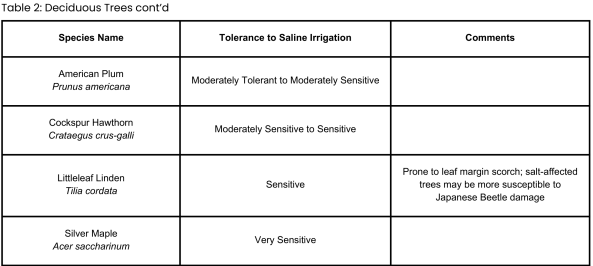by Y.L. Qian and J.E. Klett (11/23)
Quick Facts:
- The use of non-potable saline water for irrigating landscapes has led to increased salinity problems for landscape plants.
- Selecting and planting trees that have better salinity tolerance is crucial when dealing with salinity problems in landscapes.
- Tables 1 and 2 list the salt tolerance of conifers and deciduous trees common to the Front Range of Colorado.
- Landscape planners, managers, and horticulturists will find this information helpful when selecting trees for sites irrigated with saline water.
Selecting the Right Tree
Many communities in Colorado are increasingly using non-potable saline water for irrigating large landscapes, a practice that has led to rising salinity issues. When faced with salinity problems in soil and irrigation water, selecting the right tree species for planting becomes crucial. Salts can damage plants in various ways including direct foliar injury from salt spray, root osmotic stress that induces drought stress, and direct toxicity resulting from the uptake of excessive toxic ions such as sodium, chloride, and boron.
Selecting landscape trees that have better salinity tolerance can reduce or delay salt damage. Some species of trees and shrubs are more susceptible and sensitive to salts, especially after several years of exposure. Proper species selection at the time of landscape planning is important to mitigate the potential negative effects of salinity in irrigation water. Moreover, information on the relative salt tolerance of different landscape plants proves valuable during landscape renovations, allowing the replacement of susceptible plants with better adapted salt-tolerant species and cultivars.
Experimenting Among Different Trees

In order to assess the salt tolerance of common landscape plants in our region, we conducted field visits to over 25 landscape sites along the Front Range of Colorado. These sites had a history of irrigation with high or marginally high saline water. During these on-site visits, we evaluated the health and vigor of landscape plants, including assessing foliar damage, shoot dieback, and crown density. We compared these parameters with the same tree species grown under freshwater irrigation in non-saline soil to assess the salinity impacts and the degree of these impacts. Thus, we evaluated the relative salinity tolerance of commonly grown deciduous and coniferous trees. Only trees found and evaluated at multiple sites are included in this fact sheet.


We also conducted a literature review to validate our on-site observations. Numerous publications exist on salt tolerant trees and shrubs, although many of these studies originate in states with climates distinct from Colorado’s. It’s worth noting that there may be inconsistencies in salt tolerance rankings because these can vary based on whether studies consider aerial exposure or soil salt exposure. Additionally, a plant’s salt tolerance is influenced by climatic conditions such as temperature and humidity, further contributing to inconsistencies across lists. Our own on-site observations and assessments from Colorado landscapes resolved inconsistencies in the published scientific literature.
A Look at Conifers & Deciduous Trees
Tables 1 and 2 (below) rank relative salt tolerance of coniferous and deciduous tree commonly planted in urban and suburban sites along the Front Range of Colorado. In general, many deciduous trees exhibit higher salt tolerance than conifers, partly due to the annual shedding of leaves, which can help remove some salts and reduce salt accumulation in plants over many years.

Among the coniferous species we studied, junipers exhibited the highest salt tolerance (Table 1). Pinyan pine trees displayed moderate tolerance, while Ponderosa pine, Scotch pine, and Colorado blue spruce were highly sensitive, experiencing significant decline under saline water irrigation (Figure 1).
Regarding deciduous trees in our study, Russian Olive ranked as the most salt tolerant. However, Russian Olive is a noxious and invasive plant, and is not to be sold or planted in the state of Colorado. The invasive nature of Russian Olive likely intensifies under saline conditions.

Kentucky Coffeetree was ranked as highly tolerant of marginal water/saline water irrigation based on visual evaluation (Table 2). It displayed excellent visual quality and a healthy appearance at all observation sites. Silver Buffaloberry (grown as a shrub or a small tree) also showed high tolerance. Four other species (Honeylocust, Cottonwood, Green Ash, and Crabapple) were ranked as tolerant to moderately tolerant of salt.

Catalpa, Ohio Buckeye, and several Oaks were ranked as moderately tolerant. Littleleaf Linden was found to be sensitive and prone to leaf scorch, and salt-affected trees may be more susceptible to feeding damage caused by Japanese beetles (Figure 2). Silver maple is extremely sensitive to salt, displaying leaf chlorosis (light green/yellow color) and marginal scorch of leaves (Figure 3), entirely dead leaves, and dead branches when grown with saline irrigation water.
The Importance of Planning Accordingly
Because stress to trees is cumulative over time and a stressed tree is more vulnerable to additional pest or disease problems, choosing the right tree for the situation, including salt tolerance, is an important part of planning landscapes that will last into the future.





